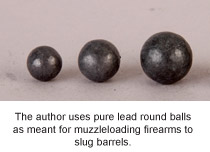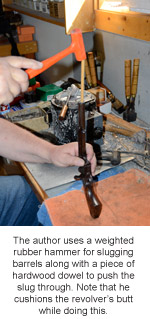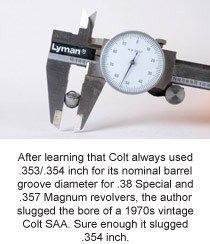
Why anyone would want to “slug” a barrel. The sole reason is to determine its size, or more precisely, its interior diameter. Why? So the proper size bullets can be sent through it. With most American made handguns of modern manufacture slugging a barrel is likely not necessary. Tolerances today are that good. With handguns of yesteryear or modern ones of foreign make, then it’s likely their barrels will vary widely.
If you are going to only handload factory jacketed bullets in your handguns, or fire only factory loads then don’t bother. You will be restricted by the diameters available anyway. For instance all 9mm factory jacketed bullets are going to be .355 inch. Conversely, if you’re going to cast your own bullets or fire commercially cast bullets then it pays to know what diameter is proper.

Here’s how to go about slugging a handgun barrel. First off a pure lead “slug” is needed. For that purpose the pure lead round balls as sold by Hornady and Speer for muzzleloaders are perfect. Pick one much larger in diameter than the barrel to be checked. For instance, if it will be a .357 Magnum then use a .375 inch pure lead round ball. If it’s a .45 caliber then I use a .490 inch one. By using large diameter round balls they will have parallel, easy to measure sides after pounded through the barrel

ONLY A LEATHER OR WOODEN MALLET OR A WEIGHTED RUBBER HAMMER SHOULD BE USED. DO NOT USE A METAL HAMMER OF ANY SORT TO POUND A SLUG INTO A BARREL! Also you’ll need a short piece of hardwood dowel a bit longer than the handgun’s barrel.
Lay the pure lead round ball atop the barrel’s muzzle. It doesn’t hurt to put a squirt of oil on it. Then pound it in flush with the muzzle using the NON-METALLIC hammer. By hammering in a much larger size ball there will be a lead flange around the muzzle. That’s ok. Just toss it aside. Tap the slug all the way through the barrel using the piece of hardwood dowel. Here’s a tip learned from hard experience. If the barrel is permanently mounted as with a revolver place its butt on something soft so you don’t chip the grips. Of course if the barrel is easily dismounted such as with a 1911 then take it out of the handgun for slugging.
Here are a couple of things that may be experienced while tapping that slug down the barrel. With many older guns it may just fall through once started. Don’t worry; that’s a sign of a tapered bore. With some other guns you may notice that the slug slides through very smoothly. That’s a sign of fine manufacturing quality. With some guns you may notice tight and loose spots. Again that’s not a great cause for worry. It’s a sign of modern manufacturing quality, which often does not equal bygone years. Here’s another tip. Be prepared to catch the slug as it exits the barrel. There’s no sense in going to this trouble and then have the soft lead slug deformed by hitting a hard floor.
Now, all one need do is measure the slug with a set of calipers or micrometer. Is it really that simple? Yes it is IF THE FIREARM IN QUESTION HAS AN EVEN NUMBER OF RIFLING GROOVES. Measuring the opposing ones gives your barrel’s groove diameter. Conversely, that’s not possible with barrels having an odd number of grooves. For instance all Smith & Wesson revolvers have five groove barrels. What to do then? Well that requires a bit extra and we’ll detail that in future.

Here is an example. It is a little known fact that Colt used a nominal groove diameter of .353/.354 inch for all .38 Special and .357 Magnum revolvers. Recently I checked a 1970 vintage Colt SAA .357 Magnum and sure enough it was right on at .354 inch.
That’s all there is to it. I could have slugged a half- dozen barrels in the time it took to write this description.
DISCLAIMER: All reloading data in this article is for informational purposes only. Starline Brass and the author accept no responsibility for use of the data in this article.